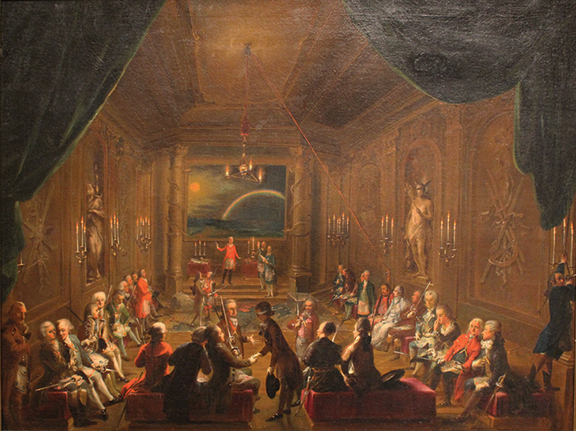Composed 1788; 45 minutes
Mozart completed his Divertimento in E-flat major, K. 563 on September 27, 1788, and entered it into the small notebook of works he kept (with a characteristic mix of languages) as “Ein Divertimento à 1 violino, 1 viola e violoncello: di sei Pezzi” – a Divertimento for violin, viola and cello in six movements. The work has been studied and analyzed by generations of composers, including Beethoven, who wrote the first of his own five trios in the same key of E-flat not long after Mozart’s death.
Externally, the music does follow many of the conventions of the late 18th century divertimento, with a pair of quick outer movements framing a sequence of two minuets and two slow movements. Internally, however, Mozart’s music reaches depths that other 18th century divertimentos fail to reach. The E-flat Divertimento is an eloquent complement to the three late symphonies Mozart wrote immediately before it (the E-flat, G minor and Jupiter) and the two late String Quintets that were to follow. The opening movement reveals an astonishing variety of sonorities. This is remarkable since Mozart generally keeps to three-part writing without filling up the textures with what’s known to string players as double-stopping – playing two notes (or more) simultaneously. As an accomplished string player, Mozart knew the ins and outs of the instruments and treats all three as absolute equals – nowhere more so than in the central development section of the opening movement where the two main themes are put through a wealth of contrapuntal interplay and some bold modulations.
Mozart then stands the descending theme of the opening movement on its head to form the rising cello theme that opens the second movement. The new theme continues to rise, with a sense of anticipation, throughout the movement, soaring at times to great heights. Its probing is never quite resolved, and the music continues to seek something not quite within reach. The first of the minuets resolves any tension that may linger. It is carefully crafted and intricately woven, yet not without moments of rustic exuberance. The opening of the second minuet hints at the hunting horn, while its central trio section sounds uncannily like Schubert at his most charming and dance-like. In between comes a highly sophisticated and seamless set of variations that gives the impression of constantly progressing into new melodies. It provides the emotional high point of the piece. By the fourth and final variation, the theme has become a shadow of itself, a bare cantus firmus that Mozart gives to the viola, while the other two strings dance around it. The theme itself has, by now, become a distant memory, until Mozart gives us a brief reminder of it in the coda. Like the variation movement, the finale is based on what appears to be a popular melody of the day. Mozart spins out its cheerful melody with good humor and then introduces a short drum-like passage that both focuses the interest and shares the musical development as this graceful movement unfolds.
Mozart in 1789, copied from a silverpoint drawing by Dorothea (Doris) Stock, believed to be the last of Mozart while alive

“I would not wish my worst enemy to be in my present situation.”
The serene and untroubled E-flat Divertimento provides a case study of art not imitating life. Mozart wrote the piece at a time of great personal difficulty when he felt compelled to write a total of 19 letters over three years to his friend and fellow Mason Johann Michael von Puchberg, begging for money. Before his death, Mozart did attempt to make several small repayments towards what grew to be a substantial debt. His widow, Constanze, managed to repay the entire debt several years later. The E-flat Divertimento may well have been designed for private music-making at the Viennese textile merchant’s house, since Mozart dedicated it to Puchberg and did not publish it during his lifetime.
